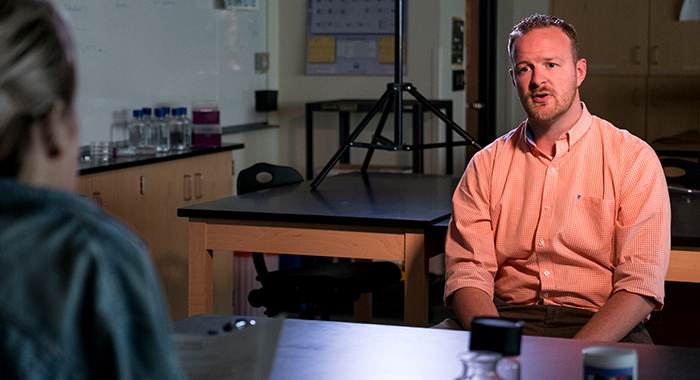Dangerous Science Draws Film Crew to Campus
A television production company from Australia, searching for an expert on a vicious shrew, found one in the Gehl-Mulva Science Center. Adam Brandt (Biology) will be featured in “72 Dangerous Animals Latin America,” a 12-part series by Showrunner Productions. Brandt was interviewed on campus about the Hispaniolan solenodon, a rare species that exists only in the Dominican Republic. The series is expected to be released in early 2018.Brandt co-authored a paper (with Alfred Roca of the the University of Illinois) about the Hispaniolan solenodon as part of a side project when he was a Ph.D. student. The research involved mitochondrial DNA analysis of blood samples from the species.
Brandt and Roca found collaborators in the Dominican Republic, through the University of Puerto Rico, to set up a sampling trip. Brandt, who has traveled to Namibia and South Africa for genetic research on elephants, was unable to be part of the solenodon expedition.
“I am a field biologist, but when you’re dealing with an international situation with a rare, threatened and endangered species, it’s hard,” he says. “That’s one field trip I didn’t get to take.”
Brandt and his collaborators sequenced the mitochondrial genome for the Hispaniolan solenodon. The study shows that the species dates back 78 million years.
“They have a unique evolutionary history,” he says. “They have some weird traits. They are nocturnal. They are sort of cute in an ugly sort of way. The solenodon is one of the few venomous mammals.” Showrunner commonly ranks species in its various themed series. In terms of being dangerous, Brandt expects the Hispaniolan solenodon to be near the bottom.
“It’s probably going to get knocked down pretty low,” he says. “It sounds dangerous because it’s venomous and has claws. They are insectivores. If you were bit, it would probably be a mild discomfort. Their venom is meant to paralyze insects and small vertebrates. If you pick them up by the tail, they don’t know what to do. They’ve never had a predator. Food and shelter is all they’ve had to worry about.”
Brandt, who joined the St. Norbert faculty last year, would like to build a research project focusing on the Hispaniolan solenodon. One question he would like to address is how many exist: The population is small. Brandt is open to getting students involved.
“If I can pull together some funding, I have a whole bunch of camera traps, so we can put up some trail cams,” he explains. “I have to build up some of the collaborations with the Dominican Republic. It took me months just to get the permits in Wisconsin to do some basic deer tagging. An endangered species internationally is a nightmare.”
“I got all my opportunities as a student, so it’s a chance to pay it forward,” he adds. “It’s my turn to give students their opportunity.”
Whether it’s for a television show or the email questions he received from a middle school student in Kentucky, Brandt is happy to share his knowledge about the solenodon. He wants to see the species continue.
“They live in the high elevations and require some decent habitats,” he says. “They survived living with dinosaurs and now we are wiping them out with habitat loss.”
Aug. 1, 2017












